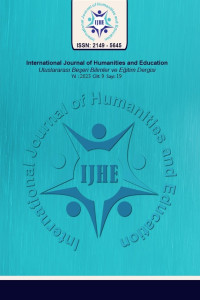Abstract
Cengiz Han’ın ve neslinin hayatlarını konu edinen eserlere Cengiznâme denir. Doğu Türkleri arasında XIII. yüzyılda ortaya çıkan Cengiznâmeler Moğol hükümdarı Cengiz Han’ın hayatı, kişiliği ve fetihleri ile ilgili olarak Cengiz Han’ın oğulları tarafından yönetilen Türkler tarafından anlatıla gelir. Kazaklar arasında derlenen Cengiznâmelerden biri olan Kazaktıñ Tübü Cengiz Han’ı “Şıñgıs” karakteriyle sembolize ederek onun atalarını, annesini, annesinin ona olağan dışı bir şekilde hamile kalışını, doğumunu, hükümdarlık becerilerini, Tanrı tarafından seçilmiş bir kişi oluşunu ve kendinden sonra gelen nesilleri anlatır. Efsanenin sonunda Kazakların büyük hanı Abılay Han ile Şıñgıs arasındaki akrabalık ilişkisine yer verilir. Makalede Kazaktıñ Tübü’nün Türkiye Türkçesi’ne yapılan çevirisinin ardından Moğolların Gizli Tarihi, Defter-i Cengiznâme ve Hannâme isimli eserlerin ilgili kısımları Kazaktıñ Tübü ile karşılaştırılmıştır. Karşılaştırma sonunda tespit edilen benzerlik ve farklılıklar açıklanmıştır. Kazaktıñ Tübü efsanesinde yer alan motifler değerlendirilmiştir. Bu efsanenin Türk Dünyasındaki Cengiz Han algısı için önemine değinilmiştir. Cengiz Han hakkında benzer bilgiler veren bir anlatının geniş Türk coğrafyasında nasıl bu kadar yaygın olduğu tartışılmıştır. Moğolların Gizli Tarihi’nde yer verilen Cengiz Han’ın köklerine dair bilgilerin kaynağının Türk boyları olabileceği tezi üzerinde durulmuştur.
Keywords
References
- Altınkaynak, E. (2007). Cengiznâme Hakkında Bazı Değerlendirmeler. Türk Dünyası İncelemeleri Dergisi, 7(1), 1-20.
- Bang-Kaup W. ve Arat R. R. (1936). Oğuz Kağan Destanı. İstanbul: İstanbul Üniversitesi Yayınları.
- Çelebi, Ö. (2022). Moğol Destancılık Geleneği ve Moğolca Cangar Destanı (Yayınlanmamış Doktora Tezi). Hacettepe Üniversitesi, Ankara.
- Çetin, N. (2011). Türk kültüründe ışık kültü (Yayınlanmamış Yüksek Lisans Tezi). Sakarya Üniversitesi, Sakarya.
- Çevik, M. (2015). Moğolların Cihan Hâkimiyet Anlayışı, Dayanak Noktaları ve Bu Konudaki Bazı Uygulamaları. Electronic Turkish Studies, 10(13), 43-56
- Çöloğlu, R. (2022). Toltoy’un Kara-Koo’dan Çıkışı ve Ergenekon, Gök Türk ve Oğuz Han Destanlarıyla Ortak Motifleri. Kahramanın Gölgesinde, Türk Destan Geleneği Üzerine Çalışmala. Çanakkale: Paradigma Akademi
- El-Ömeri. (2014). Şihabeddin b. Fazlullah, Mesaliku’l Ebsar. (çev. D. Ahsen Batur). İstanbul: Selenge Yayınları.
- Erdoğan, A. (2019). Kazak Türklerinde İdari Yapı. Kahramanmaraş Sütçü İmam Üniversitesi Sosyal Bilimler Dergisi, 16 (2), 592-612.
Abstract
The works dealing with the lives of Genghis Khan and his generation are called Genghisname. XIII. The Genghisnames, which emerged in the 16th century, are told about the life, personality and conquests of the Mongolian ruler Genghis Khan by the Turks, led by the sons of Genghis Khan. Kazaktiñ Tübü, one of the Genghisnames compiled among the Kazakhs, symbolizes Genghis Khan with the character of "Şıñgis" and tells about his ancestors, his mother, his mother's unusual pregnancy, his birth, his rulership skills, his being a person chosen by God, and the generations that follow him. At the end of the legend, the kinship between Ablai Khan, the great khan of the Kazakhs, and Şıñgis is given. In the article, after the translation of Kazaktiñ Tübü to Turkey Turkish, the relevant parts of the works named The Secret History of the Mongols, Defter-i Cengiznâme and Hannâme were compared with Kazaktiñ Tübü. The similarities and differences detected at the end of the comparison are explained. The motifs in the Kazaktiñ Tübü legend were evaluated. The importance of this legend for the perception of Genghis Khan in the Turkish World has been mentioned. It has been discussed how a narrative that gives similar information about Genghis Khan is so widespread in the wide Turkish geography. The thesis has been emphasized that the source of information about the roots of Genghis Khan, which is included in The Secret History of the Mongols, may be the Turkish tribes.
Keywords
References
- Altınkaynak, E. (2007). Cengiznâme Hakkında Bazı Değerlendirmeler. Türk Dünyası İncelemeleri Dergisi, 7(1), 1-20.
- Bang-Kaup W. ve Arat R. R. (1936). Oğuz Kağan Destanı. İstanbul: İstanbul Üniversitesi Yayınları.
- Çelebi, Ö. (2022). Moğol Destancılık Geleneği ve Moğolca Cangar Destanı (Yayınlanmamış Doktora Tezi). Hacettepe Üniversitesi, Ankara.
- Çetin, N. (2011). Türk kültüründe ışık kültü (Yayınlanmamış Yüksek Lisans Tezi). Sakarya Üniversitesi, Sakarya.
- Çevik, M. (2015). Moğolların Cihan Hâkimiyet Anlayışı, Dayanak Noktaları ve Bu Konudaki Bazı Uygulamaları. Electronic Turkish Studies, 10(13), 43-56
- Çöloğlu, R. (2022). Toltoy’un Kara-Koo’dan Çıkışı ve Ergenekon, Gök Türk ve Oğuz Han Destanlarıyla Ortak Motifleri. Kahramanın Gölgesinde, Türk Destan Geleneği Üzerine Çalışmala. Çanakkale: Paradigma Akademi
- El-Ömeri. (2014). Şihabeddin b. Fazlullah, Mesaliku’l Ebsar. (çev. D. Ahsen Batur). İstanbul: Selenge Yayınları.
- Erdoğan, A. (2019). Kazak Türklerinde İdari Yapı. Kahramanmaraş Sütçü İmam Üniversitesi Sosyal Bilimler Dergisi, 16 (2), 592-612.
Details
| Primary Language | Turkish |
|---|---|
| Journal Section | Research Article |
| Authors | |
| Publication Date | April 30, 2023 |
| Submission Date | March 21, 2023 |
| Published in Issue | Year 2023 Volume: 9 Issue: 19 |
International Journal of Humanities and Education (IJHE)
This work is licensed under a Creative Commons Attribution-NonCommercial-No Derivatives 4.0 (CC BY-NC-ND 4.0) International License.


